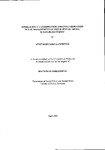INTERAGENCY COORDINATION AND COLLABORATION IN THE MANAGEMENT OF CHILD SEXUAL ABUSE: IN AUSTRALIAN AND ENGLAND
| dc.contributor.author | LAWRENCE, ANNE MARGARET | |
| dc.contributor.other | Faculty of Health | en_US |
| dc.date.accessioned | 2013-09-13T10:18:33Z | |
| dc.date.available | 2013-09-13T10:18:33Z | |
| dc.date.issued | 2001 | |
| dc.identifier | NOT AVAILABLE | en_US |
| dc.identifier.uri | http://hdl.handle.net/10026.1/1688 | |
| dc.description | Merged with duplicate record 10026.1/1282 on 27.02.2017 by CS (TIS) | |
| dc.description.abstract |
This thesis focuses on interagency coordination and collaboration in the management of child sexual abuse in Australia and in England. The impetus for the research arose from the experience of the author as manager and practitioner in the area of child sexual abuse, while working in these two countries. Problems regarding the management of interagency cooperation had become apparent in child protection practice and were also recognized in the literature. Personal experience, as well as a review of the literature, revealed that there was a need for the identification and validation of the key mechanisms and processes underlying effective interagency coordination and collaboration. This review of the literature also indicated that although existing models of operation had been identified, their value to practitioners had not been evaluated. The research underpinning the thesis set out to identify and validate key components contributing to effective interagency cooperation in the management of child sexual abuse that could be of international significance. This research is placed in the context of the evolving social construction of child abuse and child sexual abuse that is refiected in the rise in the incidence of the phenomena as well as in its expanding definitions. The nature of adult/child relationships are explored in terms of the sociological constructions of childhood and their periodisation. Specific attention is given to the rights of children and the professional regulation of child abuse and child sexual abuse in relation to the periodisation of modernity and postmodernity. Child abuse management operated mainly within the medical paradigm between the 1960s and the late 1980s. In England, child abuse tragedies occurred during the 1980s that resulted in official inquiries and culminated in various governmental reports that made recommendations for the improvement in services. The child sexual abuse scandal that occurred in Cleveland in 1986 was accompanied by a moral panic and a backlash in society against social workers and existing methods of professional regulation. As a consequence of Governmental efforts to remedy this situation, the medical paradigm that had dominated 'child abuse management' was shifted towards a socio-legal paradigm accompanied by the emergence of the discourse of 'child protectionism'. However, challenges to the child protection discourse continued and these appear to be centred mainly upon the need for the adoption of a more subjectivist paradigm in the management of these phenomena. The debates and issues arising from these shifts in paradigm, particularly in relation to the operation of the interagency, multidisciplinary approach to the management of the problem, are discussed in the context of the self-referential, closed social systems involved in child protection network. Amidst these changes to service delivery paradigms concerning child welfare, the underlying multiagency interagency method of operation continued to be advocated. Existing research had pointed to the central role of this method of working in the management of child sexual abuse. An eclectically designed study was undertaken to validate the key mechanisms and processes underlying interagency coordination and collaboration. After their identification, it was found that they could be categorised into coordinating mechanisms, collaborative procedures and personal perspectives. These key components were then operationalised to form a questionnaire that was administered to a random sample of four-hundred and seven social worker practitioners and managers in both Australia and England. This was followed up with twenty in-depth interviews with a randomly selected sample of social work managers and practitioners from Australia and England chosen from those who had participated in the original survey. The major finding from a statistical analysis of the results of the survey, and discourse analysis of the in-depth interviews, indicated that the operationalised components were key mechanisms and procedures in the management of child sexual abuse in both Australia and England. A significant outcome from these findings has been the development and integration of the key mechanisms into a model of interagency coordination and collaboration. The model has been termed, the Interagency Model for the Management of Child Sexual Abuse (IAAC). The Model's functions are outlined, together with recommendations for its practical application for the planning of child protection services as well as the training of child protection teams. The final chapter contains specific recommendations for child protection practice, in the light of the research findings, together with their possible implications for the contemporary child protection discourse. Suggestions are made regarding future directions for child protection practice, also based on the research results, together with proposals for future research. | en_US |
| dc.language.iso | en | en_US |
| dc.publisher | University of Plymouth | en_US |
| dc.title | INTERAGENCY COORDINATION AND COLLABORATION IN THE MANAGEMENT OF CHILD SEXUAL ABUSE: IN AUSTRALIAN AND ENGLAND | en_US |
| dc.type | Thesis | |
| plymouth.version | Full version | en_US |
| dc.identifier.doi | http://dx.doi.org/10.24382/4591 |
Files in this item
This item appears in the following Collection(s)
-
01 Research Theses Main Collection
Research Theses Main


